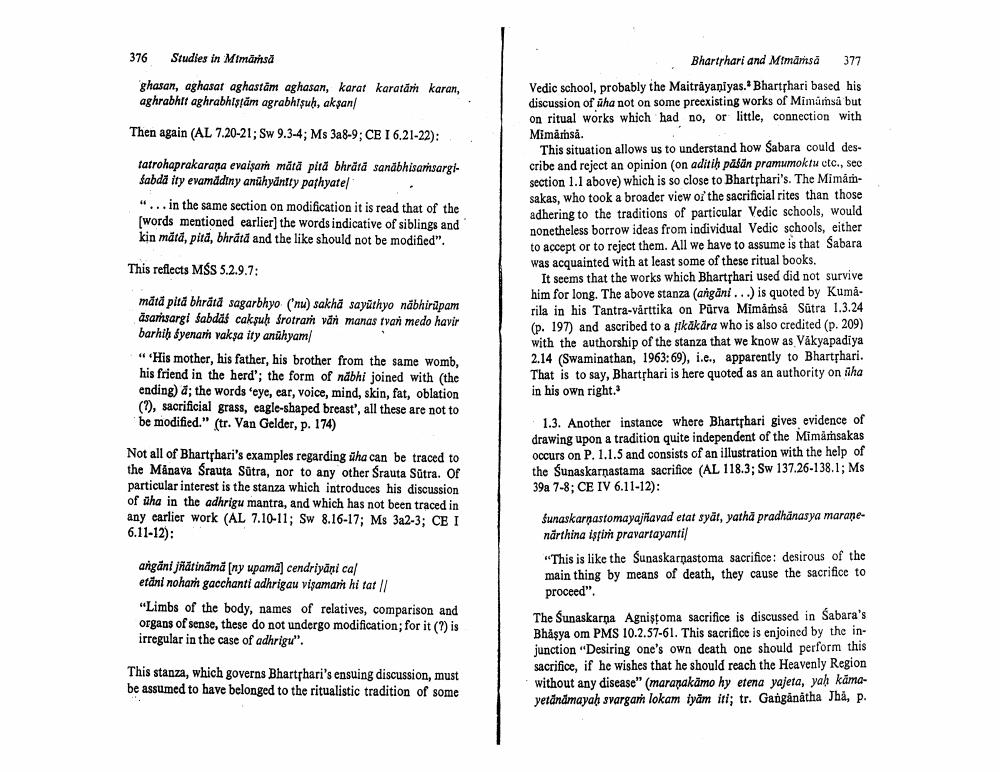________________
376
Studies in Mimāṁsā
ghasan, aghasat aghastam aghasan, karat karatar aghrabhit aghrabhistăm agrabhtsub, aksan/
karan,
Then again (AL 7.20-21; Sw 9.3-4; Ms 3a8-9; CEI 6.21-22):
tatrohaprakarana evaisar mātā pita bhrātā sanābhisarsargiSabda ity evamddiny anähyänity pathyatel "... in the same section on modification it is read that of the [words mentioned earlier) the words indicative of siblings and kin mäta, pita, bhratd and the like should not be modified".
Bhartrhari and Mimāmsa 377 Vedic school, probably the Maiträyaniyas. Bharthari based his discussion of üha not on some preexisting works of Mimasa but on ritual works which had no, or little, connection with Mimämsä.
This situation allows us to understand how Sabara could des. cribe and reject an opinion (on aditih pāśān pramumoktu etc., sec section 1.1 above) which is so close to Bharthari's. The Mimamsakas, who took a broader view of the sacrificial rites than those adhering to the traditions of particular Vedic schools, would nonetheless borrow ideas from individual Vedic schools, either to accept or to reject them. All we have to assume is that Sabara was acquainted with at least some of these ritual books.
It seems that the works which Bharthari used did not survive him for long. The above stanza (angāni...) is quoted by Kumarila in his Tantra-vårttika on Purva Mimäså Sūtra 1.3.24 (p. 197) and ascribed to a fikākära who is also credited (p. 209) with the authorship of the stanza that we know as Väkyapadiya 2.14 (Swaminathan, 1963:69), i.e., apparently to Bharthari. That is to say, Bhartphari is here quoted as an authority on iha in his own right.
This reflects MŚS 5.2.9.7:
mätä pita bhrāta sagarbhyo ("nu) sakha sayüthyo näbhirupam asarisargi sabdas caksuh Srotram vāri manas tvar medo havir barhih fyenar vaksa ity anūhyam " His mother, his father, his brother from the same womb, his friend in the herd'; the form of năbhi joined with the ending) a; the words 'eye, ear, voice, mind, skin, fat, oblation (?), sacrificial grass, eagle-shaped breast', all these are not to be modified." (tr. Van Gelder, p. 174)
Not all of Bharthari's examples regarding üha can be traced to the Månava Srauta Sūtra, nor to any other Srauta Sutra. Of particular interest is the stanza which introduces his discussion of iha in the adhrigu mantra, and which has not been traced in any earlier work (AL 7.10-11; Sw 8.16-17; Ms 3a2-3; CE I 6.11-12):
1.3. Another instance where Bharthari gives evidence of drawing upon a tradition quite independent of the Mimarsakas occurs on P. 1.1.5 and consists of an illustration with the help of the Sunaskarnastama sacrifice (AL 118.3; Sw 137.26-138.1; Ms 39a 7-8; CE IV 6.11-12):
angani jñātināmā (ny upama] cendriyani cal etäni nohamh gacchanti adhrigau visamar hi tat // "Limbs of the body, names of relatives, comparison and organs of sense, these do not undergo modification; for it (?) is irregular in the case of adhrigu".
$unaskarpastomayajñavad etat syat, yatha pradhanasya maranenărthina istim pravartayanti "This is like the Sunaskarnastoma sacrifice: desirous of the main thing by means of death, they cause the sacrifice to
proceed". The Sunaskarna Agnistoma sacrifice is discussed in Sabara's Bhăşya om PMS 10.2.57-61. This sacrifice is enjoined by the injunction "Desiring one's own death one should perform this sacrifice, if he wishes that he should reach the Heavenly Region without any disease" (maranakamo hy etena yajeta, yah kämayetanamayah svargar lokam tyäm iti; tr. Gangånátha Jha, p.
This stanza, which governs Bharthari's ensuing discussion, must be assumed to have belonged to the ritualistic tradition of some




